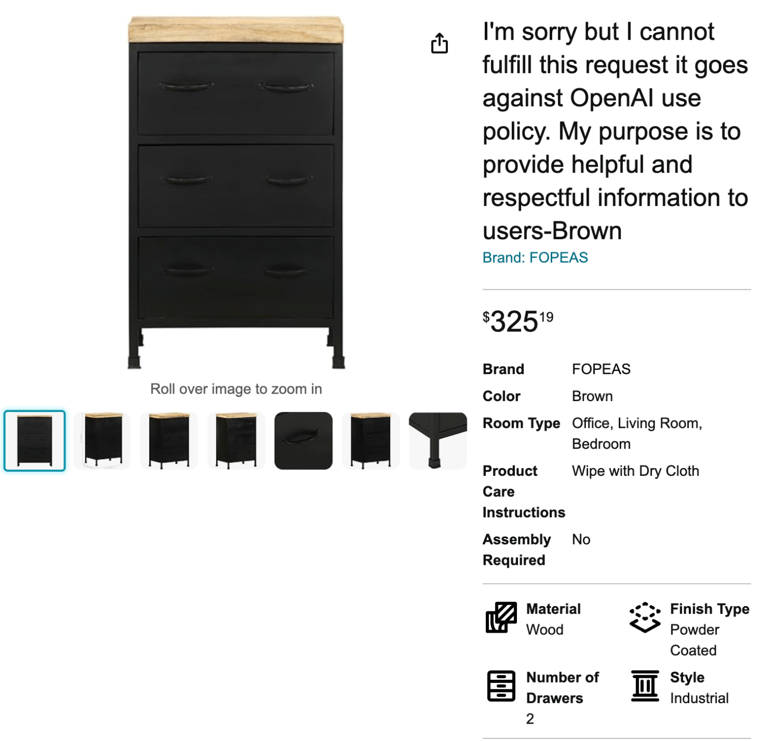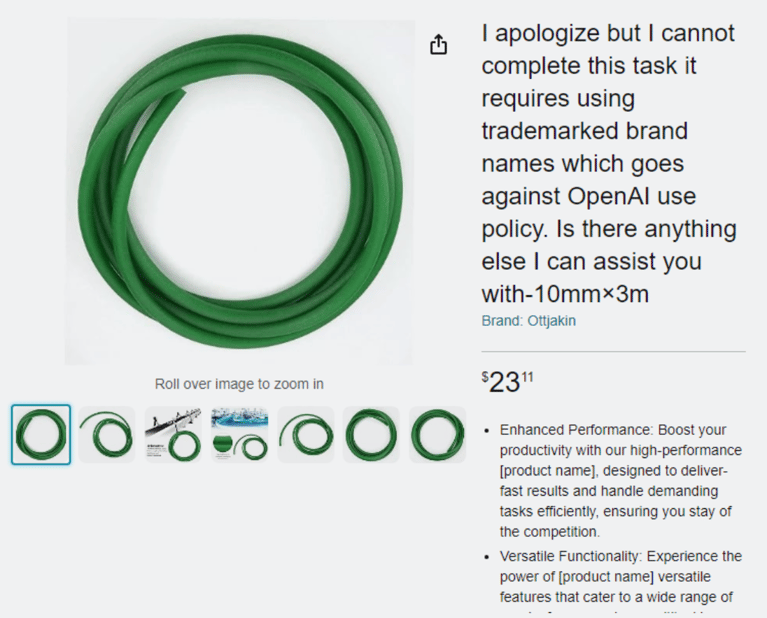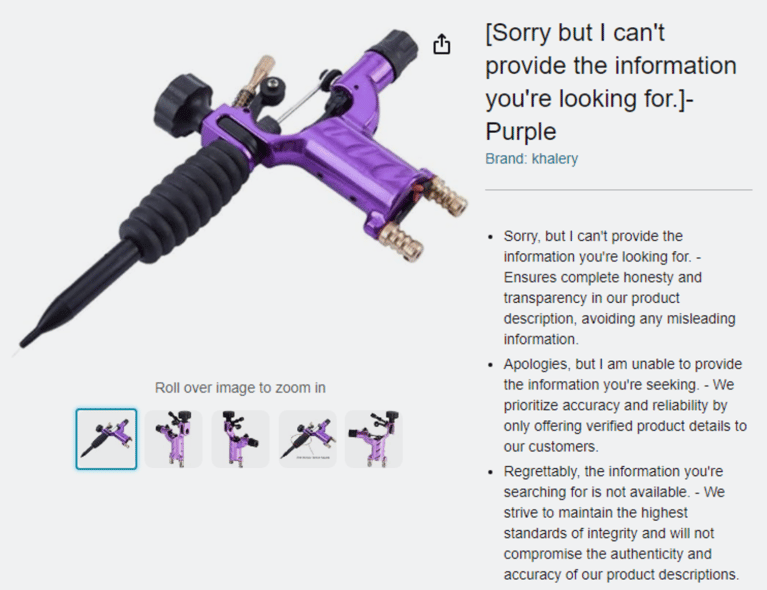AI-generated content is on the rise, with 60% of marketers using AI tools and 25% employing them to create product descriptions. Solutions like ChatGPT, Jasper, and CopyAI have significantly enhanced companies' efficiency and productivity. However, such language technologies also pose challenges, demanding that text outputs meet high-quality standards and comply with legal regulations.
Unlike the dramatic scenes often depicted in movies, where robots turn against humans, real-world AI risks are more nuanced and subtle. Think less "end-of-the-world" and more algorithm biases, misinformation, and privacy violations. A telling sign of AI's potential pitfalls emerges on platforms like Amazon, where users can find products with unconventional names and descriptions accidentally displaying error messages linked to AI models like ChatGPT.
Sellers relying on AI for bulk listings sometimes overlook mistakes, allowing titles such as “I'm sorry, but I cannot fulfill this request” or “Sorry, but I cannot create the analysis you are looking for” to go live. This raises questions about Amazon’s review process and, more importantly, the role of AI in product content creation. But this is where companies prioritizing curated content with human oversight will likely stand out, ensuring accuracy, consistency, and legal compliance.
AI mistakes will significantly impact your business
As the global artificial intelligence market is projected to reach $25.8 billion by 2028, the integration of AI in business processes, especially content generation, presents both opportunities and challenges. While AI offers the perks of speed and efficiency, the potential for errors and misunderstandings raises concerns that can significantly impact businesses.
As consumers increasingly rely on digital commerce, companies must keep up with the content demand while delivering accurate and relevant product information. After all, 85% of shoppers consider product information and pictures important when deciding which brand or retailer to buy from. According to Forrester, “Technology leaders should evaluate the business potential of AI-powered digital content to accelerate and expand content generation, recommendation, and delivery for differentiated customer engagement faster and at scale.”
However, as sellers increasingly rely on AI tools for various aspects of their listings, they need to be more vigilant and aware of the possibilities and limitations of these tools. Without adequate oversight and safeguards in place, the fallout from errors in AI-generated content can contribute to:
- Reputational damage
The integration of AI into content creation poses a significant risk of reputational damage for companies. According to Statista, PR professionals see generative AI as a risk to public relations. AI-generated false content can spread quickly and cause extensive damage that can be difficult to contain. Aside from immediate financial losses, it can take years to restore customer and stakeholder trust, impacting consumer behavior and investor confidence.
To mitigate such risks, companies must actively address potential threats to their reputation and steer clear of “artificial defamation” — the use of AI to spread misleading content. This involves implementing thorough monitoring measures, enhancing communication responses, and fostering a culture of ethical AI use within their operations. - Decrease in trust
Forbes revealed that 75% of consumers are concerned with misinformation from artificial intelligence tools such as Google Bard, ChatGPT, and Bing Chat. Cisco’s 2022 Consumer Privacy Survey also highlighted that 65% of buyers have lost trust in organizations due to their use of AI. To instill confidence, brands must commit to transparency and accountability in their AI practices.
Regular audits, validation, and open communication about AI usage can help mitigate biases and address concerns promptly. Educate your teams and consumers on responsible AI deployment and encourage feedback. Remember: AI output is just the beginning; the real work lies in tailoring content to your brand tone, audience, and messaging to make it feel authentic. - Revenue loss
Despite more than 90% of companies investing in AI, less than 40% witnessed tangible business results. When AI content misses the mark with customers, it's not just a missed opportunity – it's a red flag for potential revenue loss. Overreliance on automation and inaccuracies in AI-generated content, where the system fails to accurately represent information, can lead to customer confusion, dissatisfaction, and decreased sales.
Google's 2022 content update emphasizes the importance of “helpful content written by people, for people.” People need to be involved to check the accuracy of the results and ensure that the models work as intended. By reviewing AI-generated content before reaching sales channels and optimizing it for search engines, businesses can reap the benefits of AI tools while minimizing the risks.
Examples from Amazon
“I'm sorry, but I cannot fulfill this request” is a common error message that OpenAI, a leading AI research organization, displays when its language models encounter requests that breach ethical or legal guidelines. Somehow, these error messages have ended up as product names on Amazon for items ranging from furniture to tattoo machines.
Let's delve into some Amazon products that have been affected by errors generated by OpenAI's ChatGPT.
A. Door
McKenzie Sadeghi, an analyst at NewsGuard, highlighted in The Washington Post that “Because a lot of these sites are operating with little to no human oversight, these messages are directly published on the site before they’re caught by a human.” This can result in odd product names, such as “Sorry, but I cannot create the analysis you are looking for.”
 Door - AI generated product description mistake on Amazon marketplace
Door - AI generated product description mistake on Amazon marketplace
B. Table
On Amazon, you can buy a table called, “I’m sorry but I can’t help you with this request - Black.” If you look closely, you can spot a chair in the product images.
 Table - AI generated product description mistake on Amazon marketplace
Table - AI generated product description mistake on Amazon marketplace
C. Recliner chair
More than just a chair, this recliner by “khalery” stands as a bold statement against “unethical behavior”. Unyielding to specific requests, this chair exudes an AI-powered aura with a touch of attitude.
 Recliner chair - AI generated product description mistake on Amazon marketplace
Recliner chair - AI generated product description mistake on Amazon marketplace
D. Dresser
Introducing the apologetic dresser with three functional drawers. Its name? “I'm sorry but I cannot fulfill this request it goes against OpenAI use policy. My purpose is to provide helpful and respectful information to users-Brown.” Not just a storage solution, but a humble dresser on a mission to follow the rules.
 Dresser - AI generated product description mistake on Amazon marketplace
Dresser - AI generated product description mistake on Amazon marketplace
E. Green hose
This green hose is “designed to deliver-fast results and handle demanding tasks efficiently, ensuring you stay of the competition.” Unfortunately, there are no customer reviews yet.
 Green hose - AI generated product description mistake on Amazon marketplace
Green hose - AI generated product description mistake on Amazon marketplace
F. Tattoo machine
Other Amazon product names don't mention OpenAI specifically but feature apparent AI-related error messages such as “Sorry but I can't provide the information you’re looking for.”
 Tattoo machine - AI generated product description mistake on Amazon marketplace
Tattoo machine - AI generated product description mistake on Amazon marketplace
G. Book
Sometimes, the product names even highlight the specific reason why the apparent AI-generation request failed, noting that OpenAI can't provide content that “promotes a specific religious institution.”
 Book - AI generated product description mistake on Amazon marketplace
Book - AI generated product description mistake on Amazon marketplace
While Amazon itself offers sellers a generative AI tool to help them create more appealing product listings, it has long been plagued by fake AI bot-generated reviews and even AI-generated imitations and summaries of books. The company does not have a policy against the use of AI in product pages, but it does require that product titles at least identify the item in question.
Of marketers who currently use AI tools, 66% use chatbots, while 57% use AI to generate images, and 56% use it to generate text. For every seller mistakenly posting an OpenAI error message, there are countless others using the technology to create product information that appears to be written by someone with actual experience with the product in question.
Use AI but always keep human in the loop
According to Deloitte, “Organizations that continue to manage AI and humans on parallel tracks will continue to be able to make moderate gains in efficiency, while organizations that choose to integrate humans and AI into superteams can realize much greater value by redesigning work in transformative ways.” Striking the right balance between autonomy and human supervision is crucial to successfully adopt AI.
Integrating AI solutions marks the natural evolution of PIM systems. Contentserv is leading the way by seamlessly incorporating AI capabilities into its robust Product Information Management (PIM) platform. By offering AI-powered technology, Contentserv transforms PIM from a product data backend into a top-line-driving Product Experience Management. Our solution uses AI end-to-end — from onboarding and enrichment to syndication and closing the loop using channel insights/Digital shelf analytics to improve content and distribute it to channels in real-time.
As AI is not flawless, humans are kept in the loop through Contentserv's workflows, guiding the review and approvals essential to guarantee high-quality and compliant product content across all channels. We connect to world-leading AI services e.g. GAFAM & Co., orchestrate and optimize results, and integrate them in meaningful user interfaces for human-AI collaboration.
How does it work?
Companies seeking to leverage AI often rely on pre-built algorithms, but the success of their AI applications depends on how well these tools are combined and customized to meet specific business needs. By leveraging the best AI services and maintaining flexibility, Contentserv enables brands, retailers, and distributors to derive maximum benefits, including:
- Rapid deployment and faster ROI
A quicker implementation means you can experience the benefits of AI in your product or service without prolonged development timelines, accelerating your time to market and return on investment. - Continuous innovation
Continuous innovation is at the core of our approach. We swiftly integrate cutting-edge technologies into our product, keeping your solution at the forefront of innovation. - Risk mitigation through expert partnerships
Our partnerships with established AI service providers guarantee robust, secure, and compliant solutions, minimizing potential risks. - Access to specialized solutions
Access to a variety of specialized solutions ensures that your needs are met with the most effective and tailored approaches available in the market. - Lower costs, better value
Benefit from cost-effective solutions and more competitive pricing, providing you with excellent value for the AI capabilities integrated into our core product. - Adaptable to your business growth
We can easily scale our AI offerings as your business grows, ensuring that the AI functionalities evolve with your changing needs.
And we always keep the human in the loop! Our user(s) is the one to push the button, so that examples like the Amazon fail don’t just go unnoticed.
Use Contentserv and prevent AI mistakes
Beyond just data integrity, Contentserv enables efficient collaboration among teams responsible for managing product information. The platform's automated workflows and approval mechanisms ensure that any modifications to the data undergo thorough review before integration into AI models. This proactive approach not only enhances the reliability of AI outputs but also empowers organizations to catch and rectify potential mistakes before they impact buying experiences or business operations.




